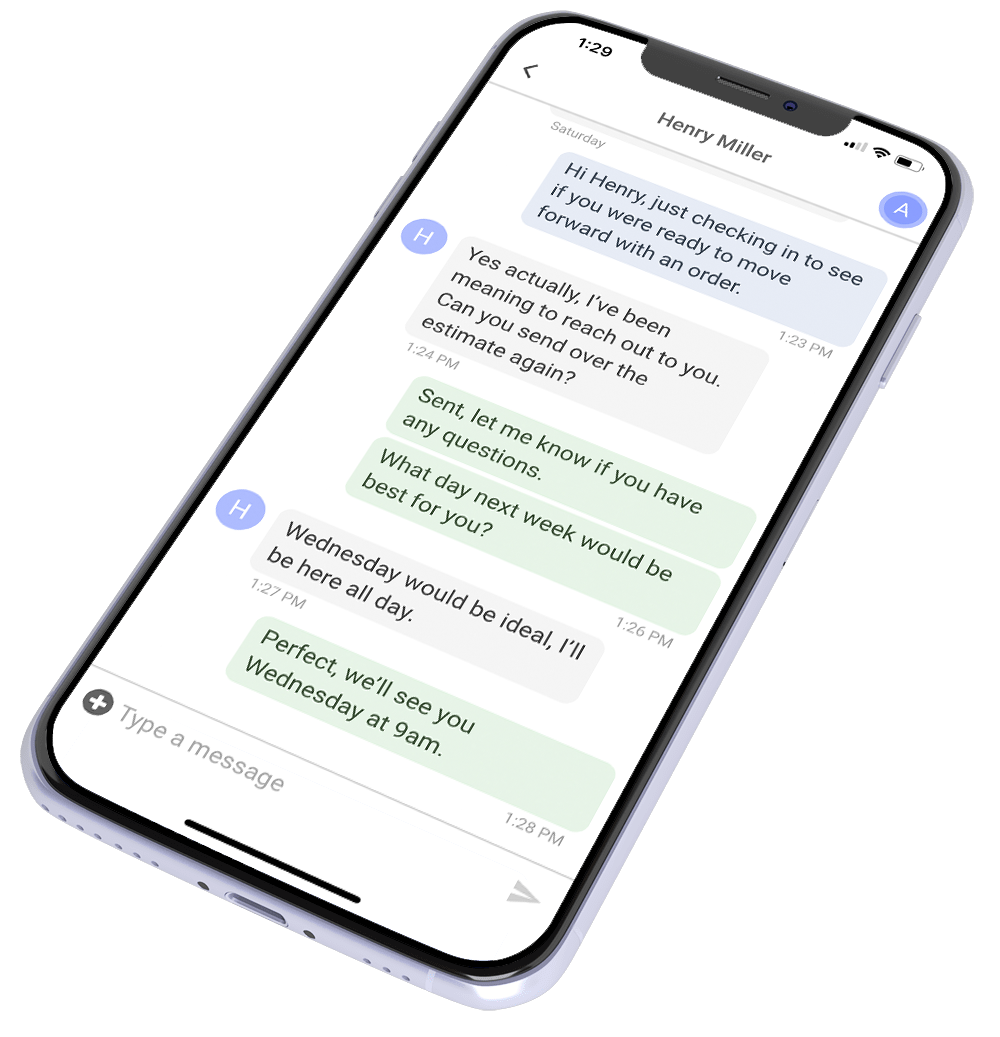
Yes, door-to-door roofing sales can work for your business in 2024. Just follow our guide to maximize your chances of success in door-to-door roofing sales.
Forget everything you’ve heard about door-knocking. It’s not just the playground for scammers and snake oil salesmen. Sure, those folks have given it a bad name, but the truth is, door-to-door roofing sales have helped legit roofers for decades. If you’ve got the guts to step up to a stranger’s porch and pitch your services, you’re already ahead of the game. Door-knocking isn’t dead. Far from it. It’s alive and kicking, and if you’re smart, you’ll make it work for you.
Is Door-Knocking Just For Scammers?
Let’s face it—scammers love door-knocking like a roofer loves a sunny day. Why? It’s easy. They can swoop in, make their pitch, and vanish before the dust settles. It’s low-cost, high-reward, and they prey on folks who might not know better. The anonymity, the ability to move from door to door without a trace—that’s the scammer’s playground. They thrive on quick hits and fast exits, leaving a trail of unhappy homeowners in their wake.
But here’s the truth—just because scammers have tainted the method doesn’t mean it’s all bad. Legit roofers, the ones who know how to build trust and deliver real value, have been using door-knocking for years with great success. It’s the same tool, but in different hands, it becomes a powerful way to connect with homeowners face-to-face, cut through the noise, and offer a solution that genuinely helps.
So, what sets the good guys apart from the con artists? First off, integrity. A real roofer doesn’t vanish after the deal; they stick around, ensuring the job’s done right and the customer’s satisfied. Second, knowledge. They don’t just pitch—they educate. They know roofs inside out and can answer any question thrown their way. Finally, follow-through. Scammers disappear once they’ve pocketed the cash. Legit roofers? They’re in it for the long haul, building relationships that lead to referrals and repeat business.
Door-knocking might have its shadows, but done right, it’s still a bright spot in a roofer’s toolkit. Don’t let the scammers scare you off—use their playbook, but with honesty and skill, and you’ll stand out every time.
How To Dominate Door-to-Door Roofing Sales
If you want to dominate roofing sales, you’ve got to understand that success doesn’t happen by chance. It’s not just about knocking on doors—it’s about knocking on the right doors at the right time with the right approach. Every detail matters, from the time of day you show up to the attitude you bring. This isn’t just sales; it’s a craft. And like any craft, it requires precision, practice, and a keen understanding of your trade.
Choose The Best Time Of Day To Door-Knock
Let’s start with the basics: timing. You can have the best pitch in the world, but if you’re knocking at the wrong hour, you’re setting yourself up for failure. Choose your moments wisely. Late afternoons to early evenings, around 4 to 7 p.m., are your golden hours. Homeowners are more relaxed, more likely to be at home, and more willing to engage. Morning hours? Skip them—people are either rushing out the door or too preoccupied to listen. Late at night? Forget about it—they’re winding down and won’t appreciate the intrusion.
So, when it comes to door-knocking, timing isn’t just important; it’s critical. Nail this, and you’re well on your way to mastering the art of roofing sales.
Choose The Right Doors
Not all doors are created equal, and in roofing sales, choosing the right ones can make or break your success. You can’t afford to waste your time knocking on every door in the neighborhood, hoping for a hit. You’ve got to be strategic, targeting the homes that are most likely to need your services and have the means to pay for them.
Start by scouting the area. Look for homes that show signs of wear and tear—aging roofs, missing shingles, or water stains. These are your prime targets. They might not know they need a new roof, but you do, and it’s your job to let them know. But don’t stop there. Consider the neighborhood’s demographics. Are you in an area where homeowners are likely to invest in quality roofing? Are they homeowners who take pride in maintaining their property, or are they more likely to delay repairs?
Also, pay attention to signs of recent storm damage or construction. Those are golden opportunities. People in these areas are already thinking about repairs, and they’re more likely to be receptive to your pitch. Avoid areas with heavy competition—if it’s been knocked on too many times before, you’re just another face in the crowd.
Choosing the right doors means being smart, observant, and a little bit picky. Focus on the homes that need your help and the homeowners who can appreciate what you bring to the table. Get this right, and you’ll find yourself closing more deals with less effort.
Pro Tip: If you’re new to door-to-door sales, try knocking on a door you know is empty. It’s a great way to build up your confidence for future knocks without the pressure of a face-to-face interaction right away.
Use Adam Bensman’s S.L.A.P. Formula
No guide to door-to-door roofing sales is complete without mentioning Adam Bensman. Specifically, his S.L.A.P. formula. It’s a straightforward approach that breaks down the sales process into simple, actionable steps, turning each knock into an opportunity rather than just a shot in the dark.
Say “Hi” and break the ice: The first step is all about making a connection. When the door opens, you’ve got just a few seconds to make a good first impression. A simple “Hi” with a genuine smile sets the tone. You’re not just a salesman; you’re a neighbor, a friendly face. Breaking the ice isn’t about jumping into your pitch right away. It’s about easing into the conversation, making the homeowner feel comfortable and open to what you’re about to say.
Let them know why you’re at their doorstep: Once you’ve got their attention, it’s time to let them know why you’re there. And here’s the key—make it personal. Reference something specific about their home or neighborhood. Mention that you’ve been working on a roof down the street, or that you noticed a few shingles missing on their roof. The more familiar and relatable you can make your reason for being there, the more likely they’ll be to listen.
Ask open-ended questions: Now comes the part where you start to dig a little deeper. Instead of launching straight into your pitch, ask questions that get them talking. Open-ended questions like, “How old is your roof?” or “Have you had any issues with leaks lately?” encourage the homeowner to share their thoughts and concerns. The more they talk, the more you learn, and the better you can tailor your presentation to their specific needs.
Present to their answer: Finally, take what you’ve learned from their answers and present a solution that meets their needs. This isn’t just about selling a roof; it’s about offering a solution to a problem they’ve acknowledged. When you tie your presentation directly to their concerns, you’re no longer just a door-to-door salesman—you’re a trusted advisor who understands their situation and has the expertise to help.
Here’s an example of it in action…
You knock on the door, and when it opens, you smile and say, “Hi there! First off, that’s a beautiful garden you’ve got out front. Second, I’m actually working on a roof just down the street and noticed your roof might be missing a few shingles. How old is your roof, if you don’t mind me asking? Have you had any issues with leaks?”
When they mention it’s been up for 15 years with no problems yet, you nod and say, “Thank goodness I said hey! Here’s how I can maybe help…”
You’ll find that each interaction becomes more natural, more engaging, and ultimately, more successful. It’s a powerful tool that turns door-knocking into an art form, one that can set you apart in the crowded world of roofing sales.
Read: 4 Door-to-Door Roofing Sales Pitches [With Examples]
The Right Attitude To Have In Door-To-Door Sales
In door-to-door sales, your attitude is your armor. You’re going to face a lot of rejection, more than you’d like to think about, but how you handle those ups and downs makes all the difference. One moment, you might be on top of the world after a great conversation; the next, you’re getting the door slammed in your face. It’s a rollercoaster, and it’s not for the faint-hearted.
To thrive in this game, you’ve got to embrace resilience. Treat every knock like a fresh start. The last door doesn’t matter—only the one in front of you. Don’t let a rough interaction knock you off your game. Stay positive, keep your energy high, and don’t take rejection personally. Remember, it’s not about you; it’s about timing, need, and often just catching someone on a bad day.
Approach each house with confidence, but leave any frustration at the curb. People can sense your mood before you say a word, so keep your mindset sharp. It’s about persistence, patience, and understanding that success in door-knocking is a numbers game. You’re planting seeds, and not everyone will sprout immediately. But with the right attitude, you’ll find that the highs outweigh the lows, and over time, those seeds will grow into solid deals.
Hiding on the other side of fear and panic is opportunity.
– Adam Bensman, the Roof Strategist
Read: Essentials for Building a Winning D2D Roofing Sales Team
Use A CRM With A Good Mobile App To Track Your Results
In door-to-door roofing sales, having a good mobile CRM isn’t just a nice-to-have; it’s a game-changer. When you’re out in the field, bouncing from one neighborhood to the next, you need a way to keep track of everything—every lead, every conversation, every follow-up. A CRM with a mobile app puts all that info right in your pocket, letting you stay organized and on top of your game no matter where you are.
The benefits of using a mobile CRM are huge. First, it keeps you efficient. You can log notes right after each interaction, so you don’t forget the details that could close the deal later. You can schedule follow-ups, track your progress, and even set reminders to circle back with prospects who weren’t ready to commit. With a mobile CRM, you can pull up previous conversations with a tap, so you’re always prepared and never scrambling to remember what was said last time.
But the real power lies in the data. Over time, you can analyze which neighborhoods are hot and which ones are not, fine-tuning your strategy to focus on the most promising areas. You can see patterns in your success and adjust your approach based on real numbers, not just gut feelings.
On the flip side, going without a mobile CRM leaves you flying blind. You’re more likely to lose track of leads, forget important details, or miss follow-ups that could’ve turned into sales. You’re also stuck relying on memory, which, after a long day of door-knocking, isn’t always sharp. Without that digital backup, you’re risking missed opportunities and lost revenue.
So, don’t cut corners. Equip yourself with a good mobile CRM, and turn your hustle into results. It’s the difference between scrambling to keep up and confidently steering your sales to success.
The Negatives of Door-to-Door Sales
It Can Feel Emotionally Brutal
Let’s not sugarcoat it—door-to-door sales can be downright brutal. Emotionally, it’s a grind like no other. You’re putting yourself out there, face to face with rejection, day in and day out. Some days, it feels like every door you knock on is a dead end, and that kind of constant pushback can wear you down. It takes a thick skin and a resilient mindset to keep going, especially when the wins seem few and far between.
It’s Time-Consuming to Master and Execute
And it’s not just the emotional toll. Door-to-door sales demand time and patience to master. You’ve got to invest hours into learning the craft, refining your pitch, and figuring out what works and what doesn’t. There’s no shortcut here—building the skills to be effective takes time. Then, there’s the execution. Knocking on doors, following up, and closing deals isn’t a quick process. It’s time-consuming, and if you’re not prepared for that, it can feel like you’re spinning your wheels with little to show for it.
Done Wrong, It Can Harm Your Brand
But perhaps the biggest risk is what happens when you do it wrong. Poorly executed door-knocking can harm your brand. Come across as too pushy or unprepared, and you’ll leave a bad taste in people’s mouths—not just for you, but for your business as a whole. It’s a fine line to walk. Push too hard, and you risk turning potential customers off; approach it too casually, and you waste your time and theirs. The stakes are high, and if you don’t handle it right, you could end up doing more harm than good.
Door-to-door sales can be powerful, but it’s not without its pitfalls. The emotional strain, the time investment, and the potential brand damage are all real. But if you’re aware of these challenges and ready to tackle them head-on, you can navigate the rough patches and come out on top.
Conclusion
Door-to-door roofing sales isn’t for the faint of heart, but if you’ve got the guts, the grit, and the game plan, it can be a powerful tool in your arsenal. Yes, it’s tough. Yes, it takes time to master. But when done right, it can open doors—literally and figuratively—that other methods simply can’t.
Don’t let the challenges hold you back. Instead, use them as fuel. Embrace the emotional rollercoaster, learn the craft, and approach each knock with purpose and confidence. Remember, every rejection is one step closer to a yes, and every door is an opportunity to build your brand, one homeowner at a time.
Now’s the time to take action. Get out there, knock with purpose, and dominate your market. Equip yourself with the right tools, the right attitude, and the right strategy, and you’ll find that door-to-door sales isn’t just a hustle—it’s your ticket to success. So, grab your pitch, lace up your boots, and let’s get to work. The next door you knock on could be your biggest win yet.
And if you need a mobile CRM, demo ProLine. It’s got the best CRM mobile app in the market!



